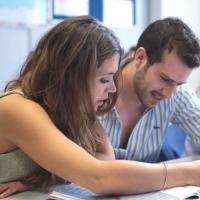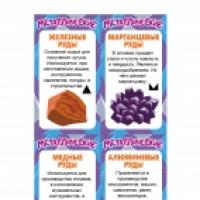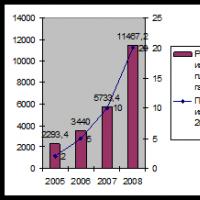What is snow. S. Ivanov. What is the snow like What is the snow like in october
Type of lesson: a lesson in obtaining new knowledge.
Objectives: to form the ability to work with the text of the work; enrich the reading experience of children; develop reading skills; introduce literary concepts; enrich the speech of students with expressive means of the language (epithets, comparisons), expand the vocabulary of children; awaken the vision of the beauty of nature.
Equipment: cards with words, musical fragments from the works of M. P. Mussorgsky, P. I. Tchaikovsky, F. Chopin, a fragment from the movie “Morozko”, TV, tape recorder, textbook: Literary reading. Grade 2 Author-status L.A. Efrosinina
During the classes
I. Organizational moment:
The bell rings merrily
Let's start our lesson.
II. Checking homework:
Guys, let's listen to Z. Alexandrova's poem "Winter", which you learned by heart (survey of 3 students).
III. Goal setting:
Guys, guess my riddle:
He is flying white flock
And sparkles on the fly.
He a cool star melts
On the palm and in the mouth.
He ruddy in the sun,
Under the blue moon.
He is behind the collar and in his pockets
Flies to us with you.
He both white and furry,
And fluffy like a bear.
Scatter it with a shovel
Name him, answer!
That's right, it's snow. And what words, comparisons helped you solve the riddle.
See how different things can be said about snow. We can see snow in a painting, in a movie, on the street. And every time we are fascinated by the beauty of snow, its originality. Let's watch an excerpt from the film "Morozko", and admire the beauty of the winter forest.
It turns out that snow can not only be drawn or seen, it can be imagined by listening to the works of writers and poets, such vivid pictures will appear before your eyes.
And today in the lesson we will get acquainted with the work of S. Ivanov and learn many interesting comparisons and epithets about what snow is like. Try to remember them, and then your speech will become richer and brighter.
IV. Learning new material.
1) Primary perception:
S. Ivanov. What is snow like (the teacher reads).
Did you like the story?
2) Work on the first part.
Let's get started with the description of snow in the first part, but before that, let's learn the meaning of a few words.
- Vocabulary and lexical work:
- Reading text in sequence.
- Post-reading conversation:
What kind of snow are we talking about in the first part? (About the first snow, about October).
- Listening to a piece of music
Listen to a piece of music that, as it were, emphasizes the timidity and lightness, the weightlessness of the first snow. (The first fragment sounds: P. I. Tchaikovsky Christmas)
Did you see the first snow, imagine it.
In this part we meet such an expression field, illuminated by the sun of life. This is a figurative expression. What kind of life do you think shines, shines in this field. (These are young sprouts)
What would you call the first part.
- The name of part 1, epithets and comparisons appear on the board.
3) Work on the second part.
And now we will meet with another snow. Let's learn the secrets of words again.
- Reading in paragraphs.
- Conversation after reading.
What snow did S. Ivanov talk about in the second part? (About January)
What is January snow like? Find in the text. (Strong and calm, oppression, break, loose)
What is said about the sun? (Looks out in the morning and lights up like a light bulb: it shines and does not heat)
What is the sky like in January? (Blue and bottomless)
And now listen and feel the power and strength of the January snow in the music. (Musical fragment by P. I. Tchaikovsky Borodino)
So what do we call the second part.
- The title of part 2, epithets and comparisons appear on the board
V. Physical minutes.
Snow Maiden - jumped, snowballs - sculpt, snowman - sat down, snowflakes - spinning.
VI. Studying a new work.
1) Work on the third part.
Let's continue to reveal the description of snow in S. Ivanov's story “What is snow like”. And let's move on to the third part.
- Dictionary-lexical work.
Let's get acquainted with some words.
- Reading to yourself.
- Conversation after reading
What words, expressions, epithets did S. Ivanov find for the February snow? (Evil, prickly, villain, witch's son, sorcerer)
Why do people walk with their hats on their foreheads? (Snow does not let you raise your head)
And this part must be read tensely, harshly, in jerky phrases, conveying the mood of the traveler and the nature of the snow. But to better understand the intonation of reading, let's listen to a piece of music. (Musical fragment by M. Mussorgsky “Hut on chicken legs”)
- intonation reading
And now let's try to read the third part together and convey the character of the February snow. (Intonation reading)
What is the title of the third part? (February snow)
- The name of the 3 parts, epithets and comparisons appear on the board
2) Work on the fourth part.
So, we come to the last fourth part and again turn to the dictionary.
- Dictionary-lexical work.
- Chain reading.
- Conversation after reading.
What snow are we talking about? (About April)
What April snow? (It is dense and sticky, like white plasticine, full of holes)
Tell me, is the April snow still clean? (No, birches are already whiter than snow)
How much snow is left? (No, he is full of holes in the thawed patches)
Let's read the April snow again.
What is the title of the fourth part? (April snow)
- The name of the 4 parts, epithets and comparisons appear on the board
VII. Generalization
What did we talk about today? (About how snow happens)
What is the first snow?
What snow in January, February, April? Name comparisons, epithets.
Complete the task in the literary notebook on page 57 No. 1.
What conclusion can we draw with you about what kind of snow is? (It is different in different months and different descriptions and comparisons are suitable for it)
- Grading.
- Homework assignment.
At home, prepare a retelling close to the text of one part you like.
Fold the landscape sheet of paper 2 times, dividing it into 4 parts. Sign each part with the name of the snow in the work and sketch, try to convey the nature of the snow with a pencil.
Development of a lesson on literary reading
for grade 2
on the topic: “What is snow like? according to S. Ivanov"
primary school teachers
Panina Irina Alexandrovna
Subject: What is snow like? according to S. Ivanov Tasks: To introduce students to the text, to form skills conscious and correct reading; - develop observation, the ability to compare the studied material with the surrounding reality and with works arts; develop communication skills in a group; - to cultivate interest in native nature, aesthetic qualities.Equipment: illustrations of paintings by K. Yuon "March snow", "March", educational cartoon "Why are all snowflakes different", video "First snow", projector, computer During the classes: I.Organizing time The bell has already rungLet's start our lesson.We turned to each otherAnd smiled a little.We wish you all good luckTo solve assigned tasks.II.Knowledge update 1.Lingual exercises -To read well, we need to knead our tongue(tongue movements forward-backward, right-left, up-down,“we brush our teeth”, “lick the jam from our lips”, the horse knocks with its hooves)2. Breathing exercises A) (blow out a large candle - exhale deeply, many small candles - jerky exhalations, a snowflake sat on the palm - blow it away)B) tongue twisterWhite snow, white chalk,White hare, also white.But the squirrel is not whiteIt wasn't even white.3. Checking homework:
A) "Competition of readers" poems by V. KirilenkoI extended my handTo grab a snowflake - a crumb,And she got caught!"Mum! That's what's in the fist! -And there is no snowflake in hand ...I didn't handle it well and she ran away.
III. The topic of the lesson. Motivation. The motto of the lesson: "It is pleasant to listen to smart speech"Riddle: He is busy all the time He cannot go in vain. He goes and paints white Everything you see along the way. (snow)In the lesson, we have to answer a number of questions (written on the side board):1. What is snow?2. What does it consist of?3. What is snow like?4. Do we need snow at all?IV. Work on lesson material
- "Problem Question"
- To find out the answer to the second question, we need only look cartoon "Why are all snowflakes different"
Let's check: did our children draw snowflakes at home correctly?
- Let's try to find the answer to the fourth question
White
 light fluffy
light fluffydazzling sparkling
- Conversation
- Work with text
- "Guess" L.V. Gurash, G.G. Klyueva, A.M. Bogush, Kyiv, 1981 "I extended my hand" V. Kirilenko Why are all snowflakes different?
Snow flutters, spins
Answers to page 58
Sergey Ivanov
What is snow
The very first snow is timid and quiet. Lies on the black October earth: “Oh! Sorry!" And melts. Only in some places he hid along the grooves left from the snake trail of the last cyclist.
First snow. It lies as if just for beauty - to only emphasize how black the land drunk with autumn water is, how the winter field sparkles freshly ... The sky is gray, the snow is white and light, as if in a watercolor painting. And the winter field shines, shines, as if it were illuminated by some invisible sun.
Sometimes you come out of the forest, you look at it - how it lies on the gentle slope of the opposite hill. And you will understand: everything around is sleeping, and this field is truly illuminated - by the sun of life.
The January snow is strong and calm. He covers the fields with a heavy cold blanket. Presses trees to the ground. And what a weaker Christmas tree - he will break it!
The sun will peek out in the morning, light up, rise high into the sky. And the sky is blue, bottomless. You look out the window - what a wonderful day! Right spring! It seems a little more - and drops will fall from the roof.
But as soon as you go out, it will take your breath away. And now you will regret that you did not take the second mittens ... Frost, well, frost! Lots of snow, lots of cold. The sun hangs at the top, like a light bulb in a refrigerator: it shines, but does not heat.
There is a blue path across the field. You walk along it - you put your foot carefully, like a tightrope walker. A slightly wrong step - knee-deep, or even waist-deep fell into a free-flowing snow swamp ... The crow pulls strainingly across the frozen icy sky: “Oh, it's cold! Oh, long before the heat!
The most evil and prickly is the February snow. One-legged blizzards circle, jump across the fields and over the forest, collide into one howling lump. And the sky is hazy, low. It seems that just stretch out your hand - and here it is ... But do not raise your hands, do not open your eyes. You walk with your hat on your forehead. And the wind just throws you, and drives you like paper.
The February snow is angry, it is fierce - it hits the traveler on the hat, on the cottony back ... Beat, beat! You won't be long... Villain! Witch! Witch's son!
And suddenly you stop: “My God, where have I wandered? Where did he take me? Oh-oh-oh! Just to get home!"
The latest snow is April. It is dense and sticky, you can’t lift it with any wind, stuck to the ground like white plasticine.
April snow is full of holes: full of holes in thawed patches, full of holes in puddles. What trees are there, what bushes are there - bumps and those begin to raise their heads. It will crawl out from under the snow - red, unkempt: “Here she is and me!”
There is still a lot of snow in the birch forest, but all of it is in small pockmarks of birch seeds-airplanes. Skis glide poorly ... I am standing in the middle of a birch kingdom. The birches are already whiter than snow. The track goes away, lost among the trunks, as if in the middle of fog.
Yesterday, Santa Claus left us along this ski track.
1. What is snow like? Specify ⇒
in October ⇒ timid
in January ⇒ heavy
in February ⇒ angry
in April ⇒ full of holes
2. Read the text silently. Prepare an expressive reading. Underline the words with which the author conveys admiration for a winter day.
The sun will come out in the morning, light up, rise high into the sky. BUT the sky is blue, bottomless. You look out the window - what a wonderful day! Right spring! It seems a little more - and drops will fall from the roof.
But just go out and take your breath away. And now you will regret that you did not take the second mittens ... Frost, well, frost! Lots of snow, lots of cold. The sun hangs at the top, like a light bulb in a refrigerator: it shines, but does not heat.
3*. Write down the description of the February snow (part 3). What does the author call snow? Emphasize.
The most evil and prickly is the February snow.The February snow is angry, it is fierce ... The villain! Witch! Witch's son!



